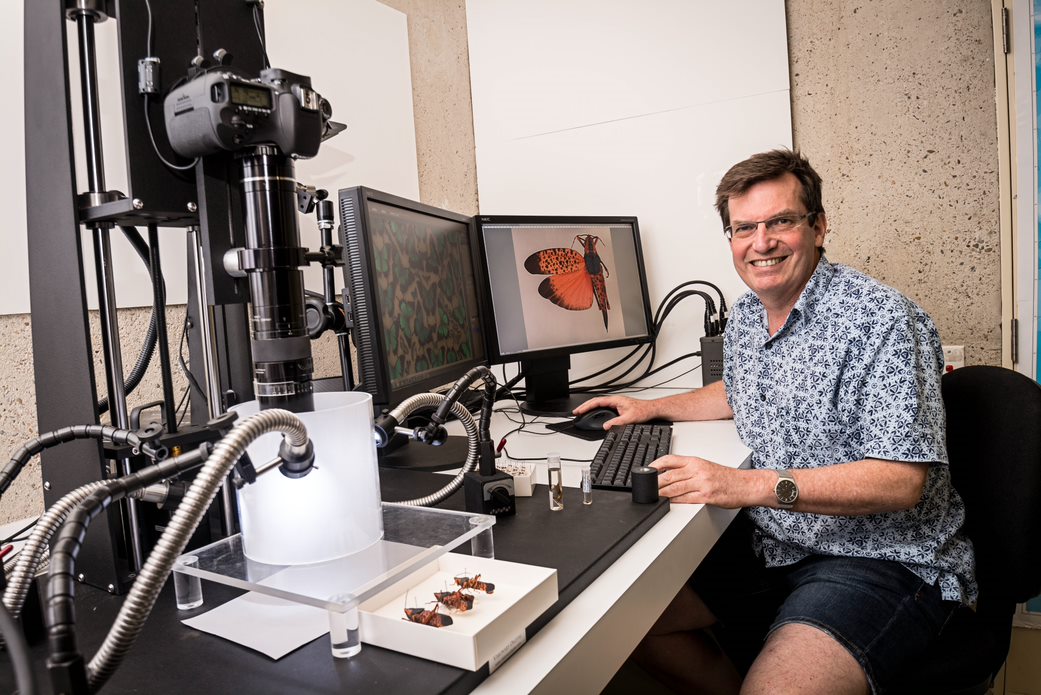August 16, 2021
Interview with Geoff Thompson
Position: Scientific Photographer, Illustrator, former Entomologist
Organisation: Queensland Museum
One-liner: “Drawing” on years of experience, Geoff Thompson is bringing the Queensland Museum’s insect collection into the digital age.

As a worker in biology, I fear for the future of the planet and all the wonderful ecosystems I have been privileged to see. I see enormous potential in technology but also enormous dangers.
The Interview
How did you get into scientific illustrations at the start of your career? Were you an artist or a scientist…or both?
STEM Girl Power
I was a science student, who applied for a job as a research assistant in entomology. When I said I could draw my boss sent me off to a scientific illustrator at CSIRO for two one-hour lessons. As I developed my skills, Sybil gave me advice on possible improvements and I gradually became a professional illustrator.
How does the development of technology help you with your day-to-day tasks as a Scientific Photographer?
Grace, Moranbah SHS
Computing power and improved algorithms are constantly improving the speed and accuracy of image processing. Improved multicoated lenses (especially in microscope objectives) and focus rails have made things visible in natural colour that we couldn’t have imagined only a few years ago.
How often would you do field work to collect samples?
STEM Girl Power
My job has changed enormously over the many years I have been doing it. I no longer get to go collecting in the field. We used to do one big, three-week trip and about five smaller trips during the warmer months of the year.
This is such a specialised field, how did you find out about the position that you are in?
Grace, Moranbah SHS
I had heard from colleagues that the job would be advertised. I applied in writing and was interviewed. There was a lot of competition but I was the lucky person who got the job.
How does the artificial intelligence of the software edit the images of samples? How do you make sure it’s accurate to what the insect really is?
STEM Girl Power
The makers of the AI software keep their secrets closely. You can see a preview of what the sharpening software will do in various modes and choose the one that has the least artifacts. When finished, I toggle between before and after, to make sure the changes are reality based.
You’ve seen scientific illustration change from hand-drawn to digital photos to software, where do you think it will go next? Is there capability to have 3D illustrations?
STEM Girl Power
I have friends and colleagues all over the world, pushing the boundaries of scientific imaging and illustration. We hope to do focus-stacked, 3D insect scanning here soon. I have talented colleagues doing 3D scientific illustrations already. https://www.miekeroth.com/3d-models/
Where do you believe the future of science is heading and what potential is there?
Grace, Kirwan SHS, Townsville
That’s a big question for someone like me, who helps scientists communicate, rather than drives research. As a worker in biology, I fear for the future of the planet and all the wonderful ecosystems I have been privileged to see (e.g. the top of Mt Elliot, home to a unique, large species of beetle, just south of you). I see enormous potential in technology but also enormous dangers.
What would be the most challenging yet interesting project of all the projects that you have investigated? And why?
Lauren, Southport SHS, Gold Coast
I think helping my former boss, Geoff Monteith, survey the insect fauna of all the rainforest mountains of the wet tropics, mostly on foot. The summits preserve the ancient cool climate of Gondwana and there we found flightless insects that have been hanging on since before the continents drifted apart, 180 million years ago. Usually, their nearest relatives are found in South America, New Caledonia, New Zealand.

Bio
Geoff Thompson is an award-winning scientific image maker at the Queensland Museum (QM). In a career spanning over 40 years he has seen scientific illustration techniques change with technological advances, from hand drawings to digital photography, and software like Topaz that uses artificial intelligence to edit and enhance images.
He worked for many years as a technician and collection manager in entomology, working closely with scientists. His works included field work in out-of-the-way rainforests and on-site at the QM, helping to maintain and enlarge the insect collection. In his current role of Collection Imager he is helping to bring the collection into the digital age.
Geoff says, “scientific illustration was a small part of my job but my major skill”…one of Geoff’s photographs was made into an artwork owned jointly by Sydney’s MCA and London’s Tate Gallery!
You can view the Youtube of Geoff Thompson’s 2021 World Science Festival session https://www.youtube.com/watch?v=2JqBl64bpqI] to learn more about scientific illustration.